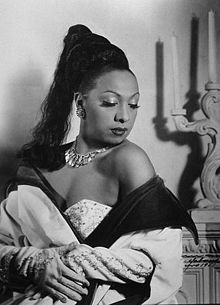Josephine Baker
Josephine Baker | |
|---|---|
 Josephine Baker in 1950 | |
| Background information | |
| Birth name | Freda Josephine McDonald |
| Born | June 3, 1906 St. Louis, Missouri, U.S.[1][2] |
| Died | April 12, 1975 (aged 68) Paris, France |
| Genres | Cabaret, Music hall |
| Occupation(s) | Dancer, singer, actress, civil rights activist, spy |
| Website | Josephine Baker profile |
| Spouse(s) | Willie Wells (1919) Willie Baker (1921) Jean Lion (1937) Jo Bouillon (1947) |
| Children | adopted 12 |


Josephine Baker (June 3, 1906 – April 12, 1975) was an American-born French dancer, singer, and actress. She was born Freda Josephine McDonald in St. Louis, Missouri. Fluent in both English and French, Baker became an international musical and political icon. She was given such nicknames as the "Bronze Venus", the "Black Pearl", and the "Créole Goddess".
Baker was the first African-American female to star in a major motion picture, Zouzou (1934), and to become a world-famous entertainer.
She tried to integrate an American concert hall,[3] and is noted for her contributions to the Civil Rights Movement in the United States. She was offered the unofficial leadership of the movement by Coretta Scott King in 1968 following Martin Luther King, Jr.'s assassination, but turned it down.[4]
Baker became a citizen of France in 1937. She helped the French Resistance during World War II,[5] and was awarded the Croix de Guerre, the Légion d'Honneur and the Rosette of the Résistance after the war.
Career
When Josephine came to Paris in the 1920s for La Revue Nègre, it was a turning point in her career. Her career thrived, and when La Revue Nègre closed, Josephine starred in La Folie du Jour at the Follies-Bergère Theater. Her performance, and her banana costume made her a celebrity. Josephine rivalled Gloria Swanson and Mary Pickford as the most photographed woman in the world: by 1927 she earned more than any entertainer in Europe. She starred in two movies in the early 1930s, Zou-Zou and Princess Tam-Tam, and moved her family from St. Louis to Les Milandes, her estate in Castelnaud-Fayrac, France.
- "A 1936 return to the United States to star in the Ziegfeld Follies proved disastrous, despite the fact that she was a major celebrity in Europe. American audiences rejected the idea of a black woman with so much sophistication and power, newspaper reviews were equally cruel (The New York Times called her a "Negro wench"), and Josephine returned to Europe heartbroken".[5]
In later shows in Paris she was often accompanied on stage by her pet cheetah, Chiquita, who was adorned with a diamond collar. The cheetah frequently escaped into the orchestra pit, where it terrorized the musicians, adding another element of excitement to the show.[3]
Personal life

Baker had 12 children through adoption. She bore only one child herself, stillborn in 1941. Josephine Baker was married four times.[6][7][8][9]
References
- ↑ "Josephine Baker (Freda McDonald) Native of St. Louis, Missouri". Retrieved 2009-03-06.
- ↑ "V & A - About Art Deco - Josephine Baker". Victoria and Albert Museum. Retrieved 2009-03-06.
- ↑ 3.0 3.1 "A Biography of Josephine Baker". Archived from the original on 2013-10-21. Retrieved 2013-01-30.
- ↑ Baker, Josephine; Bouillon, Joe 1977. Josephine. New York: Harper & Row. ISBN 0-06-010212-8
- ↑ 5.0 5.1 "About Josephine Baker: Biography" 2008. Official site of Josephine Baker. The Josephine Baker Estate. [1] Retrieved 2009-01-12.
- ↑ "Josephine Baker". cmgww.com. Retrieved August 23, 2012.
- ↑ "Josephine Baker". answers.com. Retrieved August 23, 2012.
- ↑ Strong, Lester. "Josephine Baker". gibbsmagazine. Retrieved August 23, 2012.
- ↑ "Josephine Baker's Hungry Heart". glreview.com. Archived from the original on June 22, 2009. Retrieved August 23, 2012.